2MASS Galaxy Redshift Catalog (XSCz)
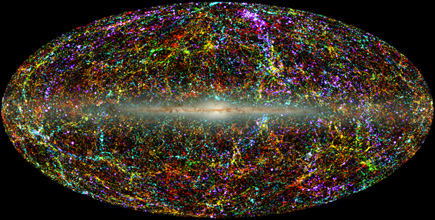
2MASS Galaxy Redshift Catalog (XSCz) |

|
| Total XSC sources: | 1,634,126 |
| XSC with K < 14 mag | 1,145,352 |
| Total photometric redshifts: | 833,611 (73% of XSCz) |
| Total radial velocities: | 311,741 (27% of XSCz) |
| ZCAT redshifts: | 193,365 |
| 2MRS redshifts: | 24,376 |
| 6dFGS redshifts: | 117,291 |
| SDSS redshifts: | 100,293 |
| 2dF redshifts: | 43,942 |
| Tully BGC: | 2,952 |
| Misc NED redshifts: | 92,912 |
| Misc LEDA redshifts: | 24,182 |
| NED-1D: Cepheid/T-F/SBF Distances: | 1068 |
| Finger-of-God Corrected redshifts: | 7,880 |
Note that the itemized redshift catalogs are not exclusive; e.g., a galaxy may have a redshift measured by SDSS but is also found in ZCAT. For a small subset of nearby galaxies, accurate distances from Cepheid, Tully-Fisher, Surface Brightness Fluctuations, etc, are used instead of redshifts; the information comes from the NED-1D table. For 4-D visualization of the XSCz (see below), large galaxy clusters are corrected for the finger-of-god radial velocity artifact, as described in the document. For M* (K-band) = -24 mag, the effective redshift is 0.094 for K=14th mag.
| redshift range | total number of sources | photometric redshifts (%total) |
photo(z) unc. | radial velocity redshifts |
number per volume 100 per Mpc^3 |
| 0 to 0.01 | 5,557 | 125 ( 2.2%) | 33.3 (%) | 5,557 (97.8%) | 1.918 |
| 0.01 to 0.02 | 17,109 | 784 (4.6%) | 34.6 (%) | 16,325 (95.4%) | 0.846 |
| 0.02 to 0.03 | 29,011 | 3,687 (12.7%) | 31.8 (%) | 25,324 (87.3%) | 0.544 |
| 0.03 to 0.04 | 46,839 | 15,540 (33.2%) | 26.7 (%) | 31,299 (66.8%) | 0.464 |
| 0.04 to 0.05 | 63,618 | 33,758 (53.1%) | 36.8 (%) | 29,860 (46.9%) | 0.393 |
| 0.05 to 0.06 | 97,669 | 65,655 (67.2%) | 34.8 (%) | 32,014 (32.8%) | 0.416 |
| 0.06 to 0.07 | 127,377 | 96,575 (75.8%) | 29.6 (%) | 30,802 (24.2%) | 0.400 |
| 0.07 to 0.08 | 149,715 | 122,208 (81.6%) | 25.8 (%) | 27,507 (18.4%) | 0.364 |
| 0.08 to 0.09 | 144,302 | 122,224 (84.7%) | 31.4 (%) | 22,078 (15.3%) | 0.281 |
| 0.09 to 0.10 | 126,839 | 110,346 (87.0%) | 34.3 (%) | 16,493 (13.0%) | 0.203 |
| 0.10 to 0.12 | 174,120 | 147,775 (84.9%) | 33.7 (%) | 26,345 (15.1%) | 0.108 |
| 0.12 to 0.14 | 90,399 | 72,475 (80.2%) | 31.5 (%) | 17,924 (19.8%) | 0.042 |
| 0.14 to 0.16 | 41,466 | 30,018 (72.4%) | 29.0 (%) | 11,448 (27.6%) | 0.015 |
| 0.16 to 0.18 | 18,831 | 12,272 (65.2%) | 32.1 (%) | 6,559 (34.83%) | 0.006 |
| 0.18 to 0.20 | 7.954 | 3,511 (44.1%) | 21.8 (%) | 4,443 (55.86%) | 0.003 |
| >0.20 | 4,420 | 807 (18.3%) | -- | 3,613 (81.74%) | -- |
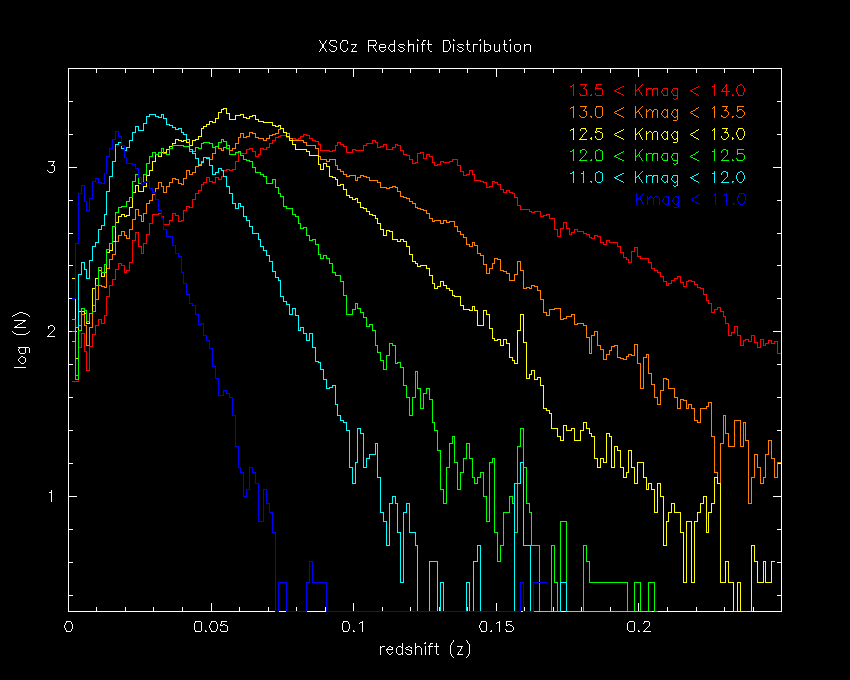 Redshift distribution of the XSCz with radial velocity measurements. |
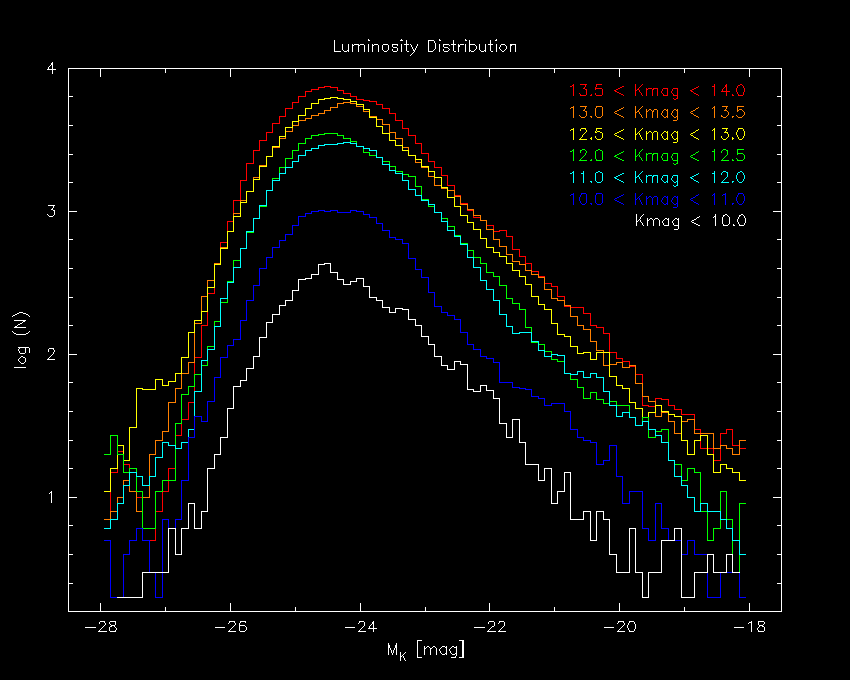 Luminosity distribution of the XSCz with radial velocity measurements. |
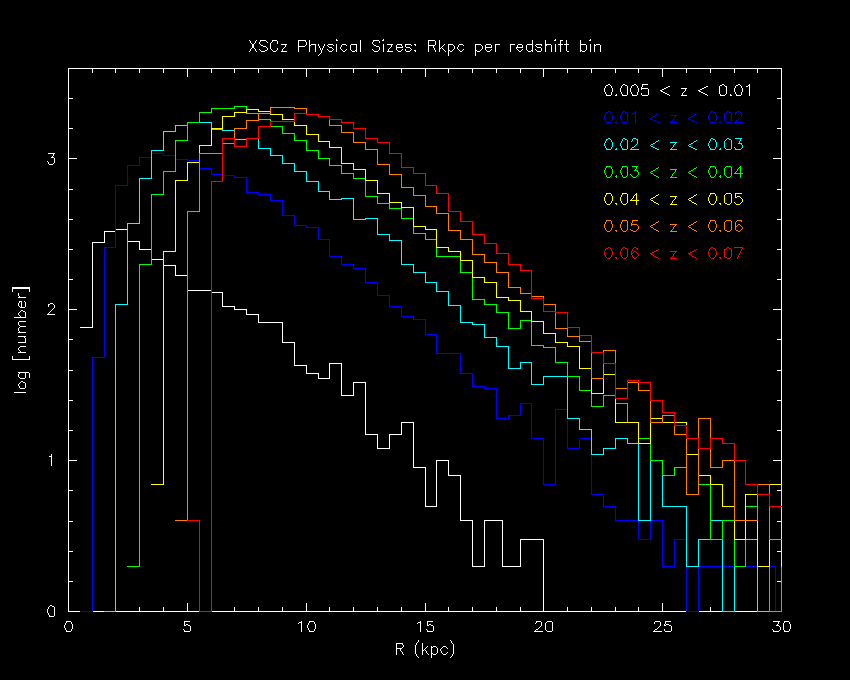 Size Distribution w/ redshift. Physical radius (kpc) based on the K=20 mag/arcsec2 isophotal radius. |
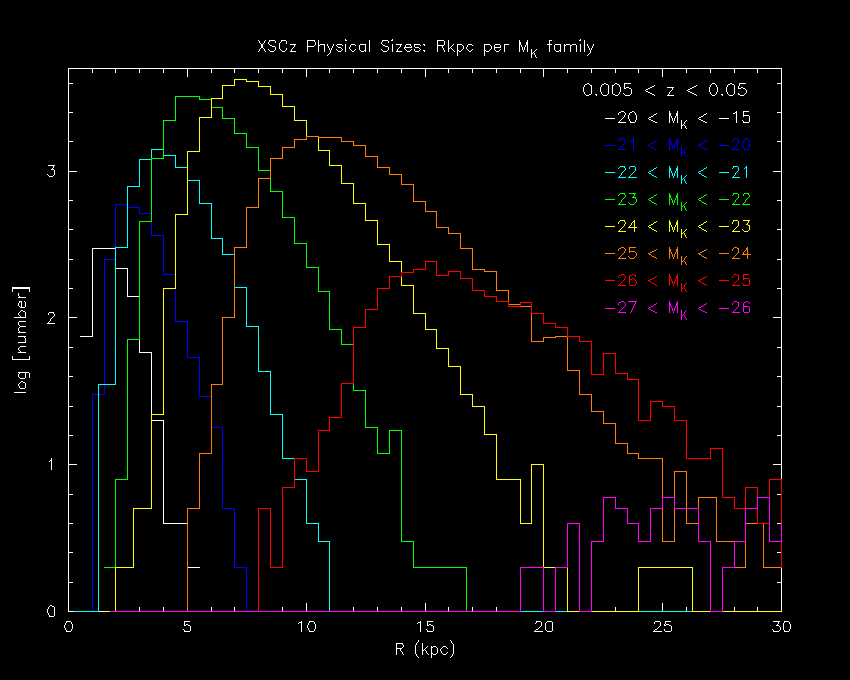 Size Distribution w/ MK. Physical radius (kpc) based on the K=20 mag/arcsec2 isophotal radius. |
| main | Introduction | Spectroscopic Redshifts | Photometric Redshifts | Finger-of-God Artifacts | Visualization Partiview | Links References |